Many things can cause a rash in babies and children, and they're often nothing to worry about.
This page covers some of the common rashes in babies and children.
As a parent, you may know if your child seems seriously unwell and should trust your judgement.
Immediate action required: Call 999 or go to A&E now if:
Your child is unwell with a rash and has any of these symptoms:
- a stiff neck
- bothered by light
- seems confused
- a high temperature
- difficulty breathing (you may notice grunting noises or their tummy sucking under their ribs), breathlessness, or they're breathing very fast
- a rash that looks like small bruises or bleeding under the skin and does not fade when you press a glass against it
- their skin, lips or tongue look pale, blue, grey or blotchy
On brown and black skin, it may be easier to see the rash or colour changes on the soles of the feet, palms, lips, tongue and inside the eyelids.
Urgent advice: Ask for an urgent GP appointment or call 111 if:
- you're worried about your child's rash and you're not sure what to do
Rash with a high temperature
Rash on cheeks with high temperature

John Kaprielian/SCIENCE PHOTO LIBRARY https://www.sciencephoto.com/media/618191/view
A rash on 1 or both cheeks plus a high temperature, runny nose, sore throat and headache may be slapped cheek syndrome.
Slapped cheek syndrome can usually be treated at home.
Slapped cheek symptoms and what to do
Slapped cheek syndrome (also called fifth disease) is common in children and should get better on its own within 3 weeks. It's rarer in adults, but can be more serious.
How long it lasts
The cheek rash usually fades within 2 weeks.
The body rash also fades within 2 weeks, but sometimes lasts for up to a month, especially if you're exercising, hot, anxious or stressed.
Adults might also have joint pain and stiffness. This can happen in children too, but it's rare. Joint pain can continue for many weeks, even after the other symptoms have gone.
If you're not sure your child has slapped cheek syndrome
Look at other rashes in babies and children.
Blisters on hands and feet plus mouth ulcers
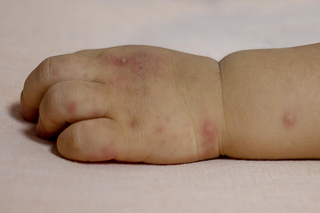
sinsy / Alamy Stock Photo https://www.alamy.com/allergic-rash-skin-of-babys-right-foot-hand-foot-and-mouth-disease-image333897813.html
Blisters on the hands and feet, with ulcers in the mouth, could be hand, foot and mouth disease.
Hand, foot and mouth disease can usually be treated at home.
Hand, foot and mouth symptoms and what to do
Check if it's hand, foot and mouth disease
The 1st signs of hand, foot and mouth disease can be:
- a sore throat
- a high temperature
- not wanting to eat
The 2nd stage usually starts a few days later and can include:
- mouth ulcers, which can be painful
- a raised rash of spots on the hands and feet, and sometimes the thighs and bottom
The rash of spots can look pink, red, or darker than the surrounding skin, depending on your skin tone.
The spots can turn into blisters, which might be grey or lighter than surrounding skin and can be painful.
The symptoms are usually the same in adults and children, but can be worse in babies and children under 5.
Mouth ulcers
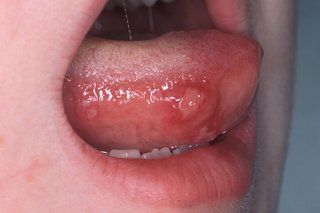
Hercules Robinson / Alamy Stock Photo https://www.alamy.com/stock-photo-vesicle-on-tongue-of-child-with-coxsackie-a16-virus-infection-hand-12876583.html?pv=1&stamp=2&imageid=E0442865-9287-42AE-A268-26DB0F32DA91&p=18517&n=0&orientation=0&pn=1&searchtype=0&IsFromSearch=1&srch=foo%3dbar%26st%3d0%26pn%3d1%26ps%3d100%26sortby%3d2%26resultview%3dsortbyPopular%26npgs%3d0%26qt%3dhand%2520foot%2520and%2520mouth%26qt_raw%3dhand%2520foot%2520and%2520mouth%26lic%3d3%26mr%3d0%26pr%3d0%26ot%3d0%26creative%3d%26ag%3d0%26hc%3d0%26pc%3d%26blackwhite%3d%26cutout%3d%26tbar%3d1%26et%3d0x000000000000000000000%26vp%3d0%26loc%3d0%26imgt%3d0%26dtfr%3d%26dtto%3d%26size%3d0xFF%26archive%3d1%26groupid%3d%26pseudoid%3d%26a%3d%26cdid%3d%26cdsrt%3d%26name%3d%26qn%3d%26apalib%3d%26apalic%3d%26lightbox%3d%26gname%3d%26gtype%3d%26xstx%3d0%26simid%3d%26saveQry%3d%26editorial%3d1%26nu%3d%26t%3d%26edoptin%3d%26customgeoip%3d%26cap%3d1%26cbstore%3d1%26vd%3d0%26lb%3d%26fi%3d2%26edrf%3d0%26ispremium%3d1%26flip%3d0%26pl%3d
Spots on the hands and feet
-
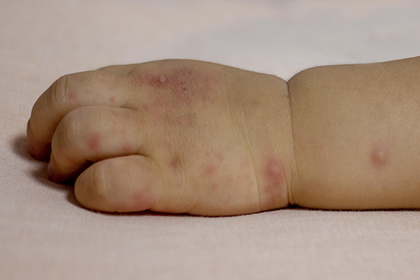 1: Hand, foot and mouth disease spots on white skin (thumbnail).
1
1: Hand, foot and mouth disease spots on white skin (thumbnail).
1
-
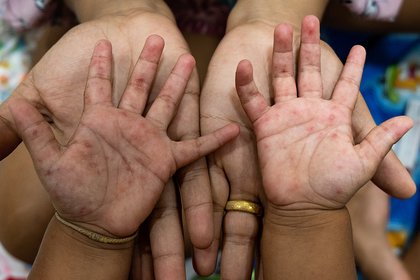 2: Hand, foot and mouth disease spots and patches on medium brown skin (thumbnail).
2
2: Hand, foot and mouth disease spots and patches on medium brown skin (thumbnail).
2
-
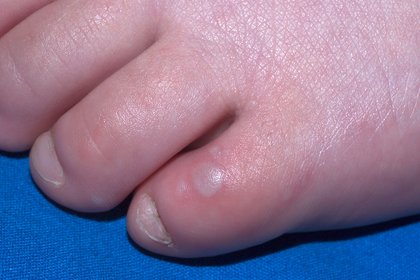 3: Hand, foot and mouth disease blister on white skin (thumbnail).
3
3: Hand, foot and mouth disease blister on white skin (thumbnail).
3

sinsy / Alamy Stock Photo https://www.alamy.com/allergic-rash-skin-of-babys-right-foot-hand-foot-and-mouth-disease-image333897813.html
Long description, image 1.
Hand, foot and mouth disease spots on the wrist and hand of a baby with white skin.
There are 3 round, raised spots and several smaller, flat spots.
The large spots vary in size from around 2mm to 5mm. 1 spot is near the knuckle of the index finger, the other 2 are near the wrist. The skin around each spot is pink. The centre of each large spot is light pink or similar to the baby's skin tone. The spots look like they have fluid in them.
There are patches of pink skin on the fingers and back of the hand.

sawatdee keawbunsong: https://www.shutterstock.com/image-photo/children-hand-foot-mouth-disease-usually-1366937726
Long description, image 2.
Hand, foot and mouth disease spots on the palms of a child with medium brown skin.
The child's palms and fingers have many pink spots and patches on them. Most spots are round, but some are an uneven shape. The centre of some spots is light pink or the same colour as the person's skin. Other spots are dark pink or red without a lighter centre.
Some spots on the joints of the fingers look like red scratches.

Scott Camazine / Alamy Stock Photo https://www.alamy.com/ulcer-in-hand-foot-and-mouth-disease-in-a-4-year-old-boy-image3361429.html?pv=1&stamp=2&imageid=8B2A7E44-B651-433D-957E-AF02E3FF727C&p=9949&n=0&orientation=0&pn=1&searchtype=0&IsFromSearch=1&srch=foo%3dbar%26st%3d0%26pn%3d1%26ps%3d100%26sortby%3d2%26resultview%3dsortbyPopular%26npgs%3d0%26qt%3dhand%2520foot%2520and%2520mouth%26qt_raw%3dhand%2520foot%2520and%2520mouth%26lic%3d3%26mr%3d0%26pr%3d0%26ot%3d0%26creative%3d%26ag%3d0%26hc%3d0%26pc%3d%26blackwhite%3d%26cutout%3d%26tbar%3d1%26et%3d0x000000000000000000000%26vp%3d0%26loc%3d0%26imgt%3d0%26dtfr%3d%26dtto%3d%26size%3d0xFF%26archive%3d1%26groupid%3d%26pseudoid%3d%26a%3d%26cdid%3d%26cdsrt%3d%26name%3d%26qn%3d%26apalib%3d%26apalic%3d%26lightbox%3d%26gname%3d%26gtype%3d%26xstx%3d0%26simid%3d%26saveQry%3d%26editorial%3d1%26nu%3d%26t%3d%26edoptin%3d%26customgeoip%3d%26cap%3d1%26cbstore%3d1%26vd%3d0%26lb%3d%26fi%3d2%26edrf%3d0%26ispremium%3d1%26flip%3d0%26pl%3d
Long description, image 3.
Hand, foot and mouth disease blisters on the little toe of a child with white skin. The skin on the top of the toe is pink. There's a large raised, round, light grey blister on the centre of the toe.
Next to the large blister are two very small white blisters.
A pharmacist can help with hand, foot and mouth disease
Ask a pharmacist for advice about treatments, such as mouth ulcer gels, sprays and mouthwashes, to relieve pain.
They can tell you which ones are suitable for children.
Rash on the face and body
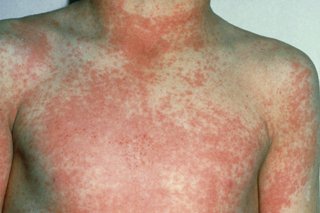
BIOPHOTO ASSOCIATES/SCIENCE PHOTO LIBRARY https://www.sciencephoto.com/media/262529/view
A rash of small, raised bumps that feels rough, like sandpaper, could be scarlet fever.
Speak to a GP if you think your child has scarlet fever.
Scarlet fever symptoms and what to do
Check if you have scarlet fever
The first signs of scarlet fever can be flu-like symptoms, including a high temperature, a sore throat and swollen neck glands (a large lump on the side of your neck).
A rash appears 12 to 48 hours later. It looks like small, raised bumps and starts on the chest and tummy, then spreads. The rash makes your skin feel rough, like sandpaper.
On white skin the rash looks pink or red. On brown and black skin it might be harder to see a change in colour, but you can still feel the rash and see the raised bumps.

BIOPHOTO ASSOCIATES/SCIENCE PHOTO LIBRARY https://www.sciencephoto.com/media/262529/view

Don't Forget The Bubbles
https://dftbskindeep.com/all-diagnoses/scarlet-fever/
https://dftbskindeep.com/all-diagnoses/scarlet-fever/#!jig[1]/ML/938
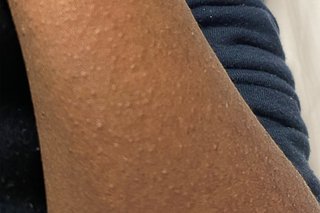
Don't Forget The Bubbles
https://dftbskindeep.com/all-diagnoses/scarlet-fever/#!jig[1]/ML/4664
https://dftbskindeep.com/all-diagnoses/scarlet-fever/
A white coating also appears on the tongue. This peels, leaving the tongue red, swollen and covered in little bumps (called "strawberry tongue").

SCIENCE PHOTO LIBRARY https://www.sciencephoto.com/media/262413/view
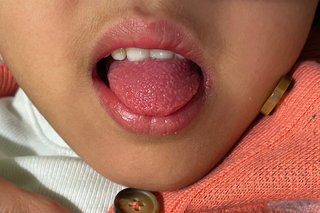
Don't Forget The Bubbles
https://dftbskindeep.com/all-diagnoses/scarlet-fever/
https://dftbskindeep.com/all-diagnoses/scarlet-fever/#!jig[1]/ML/4652
The rash does not appear on the face, but the cheeks can look red. The redness may be harder to see on brown and black skin.
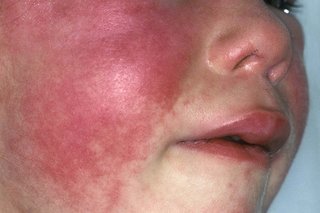
ISM/SCIENCE PHOTO LIBRARY https://www.sciencephoto.com/media/101463/view
The symptoms are the same for children and adults, although scarlet fever is less common in adults.
Non-urgent advice: See a GP if you or your child:
- have scarlet fever symptoms
- do not get better in a week (after seeing a GP)
- have scarlet fever and chickenpox at the same time
- are ill again, weeks after scarlet fever got better – this can be a sign of a complication, such as rheumatic fever
- are feeling unwell and have been in contact with someone who has scarlet fever
Scarlet fever is very easily spread. Check with a GP before you go in. They may suggest a phone consultation.
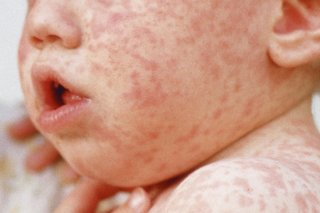
LOWELL GEORGIA/SCIENCE PHOTO LIBRARY https://www.sciencephoto.com/media/259415/view
A spotty rash that appears on the head or neck and spreads to the rest of the body could be measles.
Speak to a GP if you think your child has measles.
Measles symptoms and what to do
Check if you or your child has measles
Measles usually starts with cold-like symptoms, followed by a rash a few days later. Some people may also get small spots in their mouth.
Cold-like symptoms
The first symptoms of measles include:
- a high temperature
- a runny or blocked nose
- sneezing
- a cough
- red, sore, watery eyes
Spots in the mouth

DR P. MARAZZI/SCIENCE PHOTO LIBRARY https://www.sciencephoto.com/media/259736/view
Small white spots may appear inside the cheeks and on the back of the lips a few days later. These spots usually last a few days.
The measles rash
A rash usually appears a few days after the cold-like symptoms.
The rash starts on the face and behind the ears before spreading to the rest of the body.
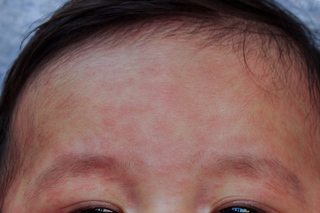
phichet chaiyabin
https://www.shutterstock.com/image-photo/measles-baby-408024505
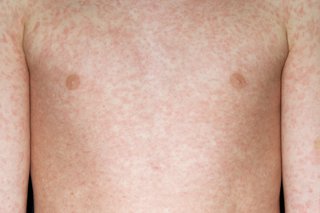
DR P. MARAZZI/SCIENCE PHOTO LIBRARY https://www.sciencephoto.com/media/259737/view
The spots of the measles rash are sometimes raised and join together to form blotchy patches. They're not usually itchy.

Mediscan / Alamy Stock Photo https://www.alamy.com/stock-photo-measles-rash-52503125.html?pv=1&stamp=2&imageid=51D0C664-0A7F-4989-BD3A-03BD405059E3&p=17774&n=0&orientation=0&pn=1&searchtype=0&IsFromSearch=1&srch=foo%3Dbar%26st%3D0%26sortby%3D2%26qt%3DD1BM7H%26qt_raw%3DD1BM7H%26qn%3D%26lic%3D3%26edrf%3D0%26mr%3D0%26pr%3D0%26aoa%3D1%26creative%3D%26videos%3D%26nu%3D%26ccc%3D%26bespoke%3D%26apalib%3D%26ag%3D0%26hc%3D0%26et%3D0x000000000000000000000%26vp%3D0%26loc%3D0%26ot%3D0%26imgt%3D0%26dtfr%3D%26dtto%3D%26size%3D0xFF%26blackwhite%3D%26cutout%3D%26archive%3D1%26name%3D%26groupid%3D%26pseudoid%3D788068%26userid%3D%26id%3D%26a%3D%26xstx%3D0%26cbstore%3D1%26resultview%3DsortbyPopular%26lightbox%3D%26gname%3D%26gtype%3D%26apalic%3D%26tbar%3D1%26pc%3D%26simid%3D%26cap%3D1%26customgeoip%3D%26vd%3D0%26cid%3D%26pe%3D%26so%3D%26lb%3D%26pl%3D0%26plno%3D%26fi%3D0%26langcode%3Den%26upl%3D0%26cufr%3D%26cuto%3D%26howler%3D%26cvrem%3D0%26cvtype%3D0%26cvloc%3D0%26cl%3D0%26upfr%3D%26upto%3D%26primcat%3D%26seccat%3D%26cvcategory%3D*%26restriction%3D%26random%3D%26ispremium%3D1%26flip%3D0%26contributorqt%3D%26plgalleryno%3D%26plpublic%3D0%26viewaspublic%3D0%26isplcurate%3D0%26imageurl%3D%26saveQry%3D%26editorial%3D1%26t%3D0%26edoptin%3D
The rash looks brown or red on white skin. It may be harder to see on brown and black skin.
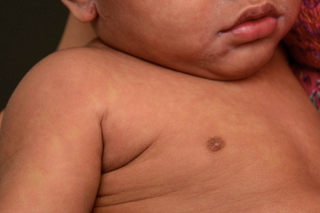

Don't Forget The Bubbles - Skin Deep: https://dftbskindeep.com/wp-content/uploads/2020/08/M11-measles-1024x1024.jpg
Urgent advice: Ask for an urgent GP appointment or get help from NHS 111 if:
- you think you or your child may have measles
- your child is under 1 year old and has come into contact with someone who has measles
- you've been in close contact with someone who has measles and you're pregnant or have a weakened immune system
- you or your child have a high temperature that has not come down after taking paracetamol or ibuprofen
- you or your child have difficulty breathing – you may feel more short of breath than usual
- your baby or young child is not feeding well, or taking less feeds or fluids than usual
- you or your child are peeing less than usual (or your baby has fewer wet nappies)
- you or your child feels very unwell, or you're worried something is seriously wrong
Measles can spread to others easily. Call your GP surgery before you go in. They may suggest talking over the phone.
You can also call 111 or get help from 111 online.
Rash with itching
Rash caused by heat

Disney Magic / Alamy Stock Photo https://www.alamy.com/stock-photo-too-much-sun-heat-rash-on-teenager-27967975.html?pv=1&stamp=2&imageid=34A1C03C-91F3-46AF-9D0A-5DC745DB48D1&p=148024&n=0&orientation=0&pn=1&searchtype=0&IsFromSearch=1&srch=foo%3dbar%26st%3d0%26pn%3d1%26ps%3d100%26sortby%3d2%26resultview%3dsortbyPopular%26npgs%3d0%26qt%3dBHE1C7%26qt_raw%3dBHE1C7%26lic%3d3%26mr%3d0%26pr%3d0%26ot%3d0%26creative%3d%26ag%3d0%26hc%3d0%26pc%3d%26blackwhite%3d%26cutout%3d%26tbar%3d1%26et%3d0x000000000000000000000%26vp%3d0%26loc%3d0%26imgt%3d0%26dtfr%3d%26dtto%3d%26size%3d0xFF%26archive%3d1%26groupid%3d%26pseudoid%3d%26a%3d%26cdid%3d%26cdsrt%3d%26name%3d%26qn%3d%26apalib%3d%26apalic%3d%26lightbox%3d%26gname%3d%26gtype%3d%26xstx%3d0%26simid%3d%26saveQry%3d%26editorial%3d1%26nu%3d%26t%3d%26edoptin%3d%26customgeoip%3d%26cap%3d1%26cbstore%3d1%26vd%3d0%26lb%3d%26fi%3d2%26edrf%3d0%26ispremium%3d1%26flip%3d0%26pl%3d
A rash of small, raised spots that feels itchy or prickly could be heat rash (prickly heat).
Heat rash can usually be treated at home.
Heat rash symptoms and what to do
Check if you have heat rash
The symptoms of heat rash are:
- small, raised spots
- an itchy, prickly feeling
- mild swelling
The rash often looks red, but this may be less obvious on brown or black skin.
The symptoms of heat rash are often the same in adults and children.
It can appear anywhere on the body and spread, but it cannot be passed on to other people.

CID - ISM / SCIENCE PHOTO LIBRARY https://www.sciencephoto.com/media/1036411/view
How you can treat or prevent heat rash yourself
The main thing to do is keep your skin cool so you do not sweat and irritate the rash.
To keep your skin cool
- wear loose cotton clothing
- use lightweight bedding
- take cool baths or showers
- drink plenty of fluid to avoid dehydration
To calm the itching or prickly feeling
- apply something cold, such as a damp cloth or ice pack (wrapped in a tea towel) for up to 20 minutes
- tap or pat the rash instead of scratching it
- do not use perfumed shower gels or creams
Scaly or cracked skin
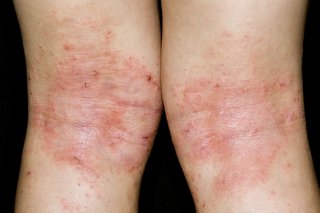
DR P. MARAZZI/SCIENCE PHOTO LIBRARY https://www.sciencephoto.com/media/146559/view

Science Photo Library https://www.sciencephoto.com/media/494291/view
Skin that's itchy, dry and cracked may be atopic eczema. It's common behind the knees, elbows and neck, but it can appear anywhere.
Speak to a GP if you think your child has eczema.
Find out more about atopic eczema
Raised, itchy spots or patches
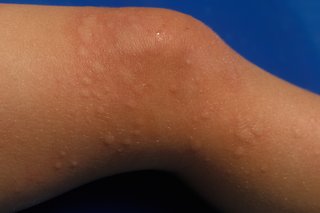
Loisjoy Thurstun / Alamy Stock Photo https://www.alamy.com/close-up-of-toddler-with-urticaria-caused-by-sensitivity-to-plum-skins-image8981367.html?pv=1&stamp=2&imageid=51FCF349-CE6C-46DB-B51B-CBCAE97EA94D&p=373224&n=0&orientation=0&pn=1&searchtype=0&IsFromSearch=1&srch=foo%3Dbar%26st%3D0%26sortby%3D2%26qt%3DAP98R8%26qt_raw%3DAP98R8%26qn%3D%26lic%3D3%26edrf%3D0%26mr%3D0%26pr%3D0%26aoa%3D1%26creative%3D%26videos%3D%26nu%3D%26ccc%3D%26bespoke%3D%26apalib%3D%26ag%3D0%26hc%3D0%26et%3D0x000000000000000000000%26vp%3D0%26loc%3D0%26ot%3D0%26imgt%3D0%26dtfr%3D%26dtto%3D%26size%3D0xFF%26blackwhite%3D%26cutout%3D%26archive%3D1%26name%3D%26groupid%3D%26pseudoid%3D%26userid%3D%26id%3D%26a%3D%26xstx%3D0%26cbstore%3D1%26resultview%3DsortbyPopular%26lightbox%3D%26gname%3D%26gtype%3D%26apalic%3D%26tbar%3D1%26pc%3D%26simid%3D%26cap%3D1%26customgeoip%3D%26vd%3D0%26cid%3D%26pe%3D%26so%3D%26lb%3D%26pl%3D0%26plno%3D%26fi%3D0%26langcode%3Den%26upl%3D0%26cufr%3D%26cuto%3D%26howler%3D%26cvrem%3D0%26cvtype%3D0%26cvloc%3D0%26cl%3D0%26upfr%3D%26upto%3D%26primcat%3D%26seccat%3D%26cvcategory%3D*%26restriction%3D%26random%3D%26ispremium%3D1%26flip%3D0%26contributorqt%3D%26plgalleryno%3D%26plpublic%3D0%26viewaspublic%3D0%26isplcurate%3D0%26imageurl%3D%26saveQry%3D%26editorial%3D1%26t%3D0%26edoptin%3D
Raised, itchy patches or spots could be caused by an allergic reaction (hives).
Hives can usually be treated at home. But call 999 if there's swelling around your child's mouth or they're struggling to breathe.
Hives symptoms and what to do
Check if it's hives
The main symptom of hives is an itchy rash.
The rash can:
- be raised bumps or patches in many shapes and sizes
- appear anywhere on the body
- be on 1 area or spread across the body
- feel itchy, sting or burn
- look pink or red when affecting someone with white skin; the colour of the rash can be harder to see on brown and black skin
-
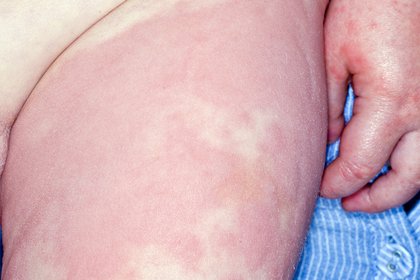 1: White skin with hives rash (thumbnail).
1
1: White skin with hives rash (thumbnail).
1
-
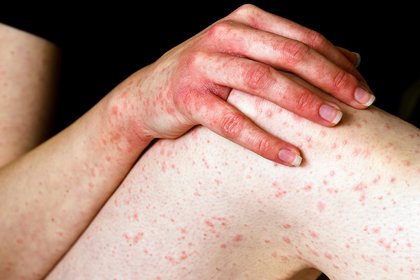 2: White skin with hives rash (thumbnail).
2
2: White skin with hives rash (thumbnail).
2
-
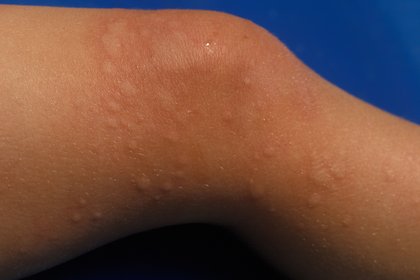 3: Hives rash on light brown skin (thumbnail).
3
3: Hives rash on light brown skin (thumbnail).
3
-
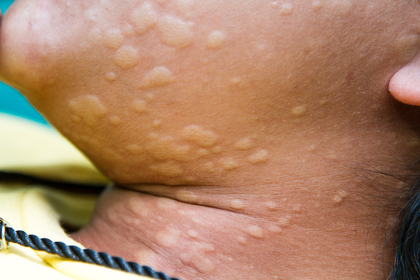 4: Hives rash on light brown skin (thumbnail).
4
4: Hives rash on light brown skin (thumbnail).
4
-
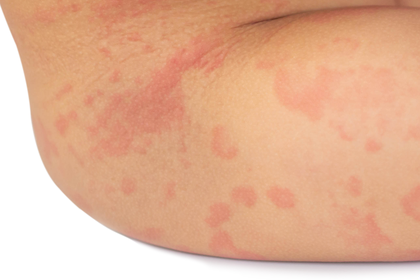 5: Hives rash on light brown skin (thumbnail).
5
5: Hives rash on light brown skin (thumbnail).
5
-
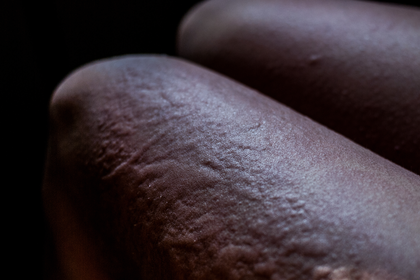 6: Dark brown skin with hives rash (thumbnail).
6
6: Dark brown skin with hives rash (thumbnail).
6

DR P. MARAZZI/SCIENCE PHOTO LIBRARY https://www.sciencephoto.com/media/694159/view
Long description, image 1.
Hives rash on the leg and hand of a child with white skin.
The skin on most of their thigh is pink, raised and bumpy. At the side of their thigh, close to their hand, are deep creases in the skin.
Their hand is pink with some red patches between their thumb and finger and on their fingertips.

Elizabeth Nunn / Alamy Stock Photo https://www.alamy.com/stock-photo-an-urticarial-rash-caused-by-an-allergic-reaction-to-penicillin-111762116.html?pv=1&stamp=2&imageid=261CE1C1-DA64-4EAE-8D55-1794DA842BD3&p=278658&n=0&orientation=0&pn=1&searchtype=0&IsFromSearch=1&srch=foo%3dbar%26st%3d0%26pn%3d1%26ps%3d100%26sortby%3d2%26resultview%3dsortbyPopular%26npgs%3d0%26qt%3dGDR5M4%26qt_raw%3dGDR5M4%26lic%3d3%26mr%3d0%26pr%3d0%26ot%3d0%26creative%3d%26ag%3d0%26hc%3d0%26pc%3d%26blackwhite%3d%26cutout%3d%26tbar%3d1%26et%3d0x000000000000000000000%26vp%3d0%26loc%3d0%26imgt%3d0%26dtfr%3d%26dtto%3d%26size%3d0xFF%26archive%3d1%26groupid%3d%26pseudoid%3d%26a%3d%26cdid%3d%26cdsrt%3d%26name%3d%26qn%3d%26apalib%3d%26apalic%3d%26lightbox%3d%26gname%3d%26gtype%3d%26xstx%3d0%26simid%3d%26saveQry%3d%26editorial%3d1%26nu%3d%26t%3d%26edoptin%3d%26customgeoip%3d%26cap%3d1%26cbstore%3d1%26vd%3d0%26lb%3d%26fi%3d2%26edrf%3d0%26ispremium%3d1%26flip%3d0%26pl%3d
Long description, image 2.
Hives rash on the leg, arm and hand of a person with white skin.
Small, slightly raised pink spots cover their leg. Some are close together and some are further apart.
The same spotty rash spreads along the side of their arm and across the top of their hand. The knuckles and fingertips are red.

Loisjoy Thurstun / Alamy Stock Photo https://www.alamy.com/close-up-of-toddler-with-urticaria-caused-by-sensitivity-to-plum-skins-image8981367.html?pv=1&stamp=2&imageid=51FCF349-CE6C-46DB-B51B-CBCAE97EA94D&p=373224&n=0&orientation=0&pn=1&searchtype=0&IsFromSearch=1&srch=foo%3Dbar%26st%3D0%26sortby%3D2%26qt%3DAP98R8%26qt_raw%3DAP98R8%26qn%3D%26lic%3D3%26edrf%3D0%26mr%3D0%26pr%3D0%26aoa%3D1%26creative%3D%26videos%3D%26nu%3D%26ccc%3D%26bespoke%3D%26apalib%3D%26ag%3D0%26hc%3D0%26et%3D0x000000000000000000000%26vp%3D0%26loc%3D0%26ot%3D0%26imgt%3D0%26dtfr%3D%26dtto%3D%26size%3D0xFF%26blackwhite%3D%26cutout%3D%26archive%3D1%26name%3D%26groupid%3D%26pseudoid%3D%26userid%3D%26id%3D%26a%3D%26xstx%3D0%26cbstore%3D1%26resultview%3DsortbyPopular%26lightbox%3D%26gname%3D%26gtype%3D%26apalic%3D%26tbar%3D1%26pc%3D%26simid%3D%26cap%3D1%26customgeoip%3D%26vd%3D0%26cid%3D%26pe%3D%26so%3D%26lb%3D%26pl%3D0%26plno%3D%26fi%3D0%26langcode%3Den%26upl%3D0%26cufr%3D%26cuto%3D%26howler%3D%26cvrem%3D0%26cvtype%3D0%26cvloc%3D0%26cl%3D0%26upfr%3D%26upto%3D%26primcat%3D%26seccat%3D%26cvcategory%3D*%26restriction%3D%26random%3D%26ispremium%3D1%26flip%3D0%26contributorqt%3D%26plgalleryno%3D%26plpublic%3D0%26viewaspublic%3D0%26isplcurate%3D0%26imageurl%3D%26saveQry%3D%26editorial%3D1%26t%3D0%26edoptin%3D
Long description, image 3.
Hives rash on the knee of a person with light brown skin. The skin is slightly darker brown around where the rash is.
There are many skin-coloured bumps on and around the knee which vary in size from around 2mm to 1cm. The larger bumps look puffy like blisters. Some bumps are very close together in groups.

konmesa :https://www.shutterstock.com/image-photo/urticaria-301493921
Long description, image 4.
Hives rash on the cheek, chin and neck of a person with light brown skin.
There are about 50 raised bumps in different shapes and sizes.
Some of the bumps are small circles and others are larger, uneven shapes. Most are close together in groups, but some are further apart. The bumps are a lighter brown than the surrounding skin and look puffy, like blisters.

Arlee. P: https://www.shutterstock.com/image-photo/child-symptoms-itchy-urticaria-body-arm-1101565460
Long description, image 5.
Hives rash on the thigh and hip of a child with light brown skin.
There are about 20 patches of pink skin in different shapes and sizes. The patches are mainly flat and vary in size from around 1cm to 8cm.
Some patches are close to or join others, while some are further apart.
Some patches are dark pink. Others are lighter pink with a darker pink border around the patch.
There's a long, dark pink patch spreading from their groin to their hip.

Apiwut Sookkasame
https://www.shutterstock.com/image-photo/urticaria-on-legs-1040514490
Long description, image 6.
Hives rash on the thigh of a person with dark brown skin.
There are many raised patches of skin in different shapes and sizes very close to each other. They range from around 5mm to 5cm.
The skin near the left knee also has raised lines, like scars. The skin on the inside of the thigh is smooth.
The rash is the same colour as the person's skin.
A pharmacist can help with hives
A pharmacist can give you advice about antihistamine treatment to help a hives rash.
Tell the pharmacist if you have a long-term condition, because you might not be able to take antihistamines.
This treatment might not be suitable for young children.
Immediate action required: Call 999 if:
- your lips, mouth, throat or tongue suddenly become swollen
- you're breathing very fast or struggling to breathe (you may become very wheezy or feel like you're choking or gasping for air)
- your throat feels tight or you're struggling to swallow
- your skin, tongue or lips turn blue, grey or pale (if you have black or brown skin, this may be easier to see on the palms of your hands or soles of your feet)
- you suddenly become very confused, drowsy or dizzy
- someone faints and cannot be woken up
- a child is limp, floppy or not responding like they normally do (their head may fall to the side, backwards or forwards, or they may find it difficult to lift their head or focus on your face)
You or the person who's unwell may also have a rash that's swollen, raised or itchy.
These can be signs of a serious allergic reaction and may need immediate treatment in hospital.
Itchy round rash

Robert Read / Alamy Stock Photo https://www.alamy.com/stock-photo-ringworm-fungus-infection-tinea-corporis-on-young-boys-arm-28065227.html?pv=1&stamp=2&imageid=770CEC29-2401-4E1E-AC03-DF6443D870C5&p=22841&n=0&orientation=0&pn=1&searchtype=0&IsFromSearch=1&srch=foo%3dbar%26st%3d0%26pn%3d1%26ps%3d100%26sortby%3d2%26resultview%3dsortbyPopular%26npgs%3d0%26qt%3dBHJDDF%26qt_raw%3dBHJDDF%26lic%3d3%26mr%3d0%26pr%3d0%26ot%3d0%26creative%3d%26ag%3d0%26hc%3d0%26pc%3d%26blackwhite%3d%26cutout%3d%26tbar%3d1%26et%3d0x000000000000000000000%26vp%3d0%26loc%3d0%26imgt%3d0%26dtfr%3d%26dtto%3d%26size%3d0xFF%26archive%3d1%26groupid%3d%26pseudoid%3d788068%26a%3d%26cdid%3d%26cdsrt%3d%26name%3d%26qn%3d%26apalib%3d%26apalic%3d%26lightbox%3d%26gname%3d%26gtype%3d%26xstx%3d0%26simid%3d%26saveQry%3d%26editorial%3d1%26nu%3d%26t%3d%26edoptin%3d%26customgeoip%3d%26cap%3d1%26cbstore%3d1%26vd%3d0%26lb%3d%26fi%3d2%26edrf%3d0%26ispremium%3d1%26flip%3d0%26pl%3d
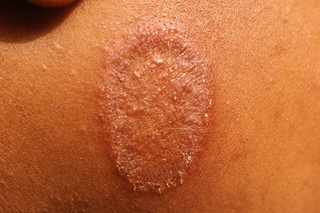
BSIP SA / Alamy Stock Photo https://www.alamy.com/stock-photo-herpes-49178293.html?pv=1&stamp=2&imageid=6D4451FF-983E-41A0-91D1-7FA4B294D4D7&p=166014&n=465&orientation=0&pn=1&searchtype=0&IsFromSearch=1&srch=foo%3Dbar%26st%3D0%26sortby%3D3%26qt%3Dringworm%26qt_raw%3Dringworm%26qn%3D%26lic%3D3%26edrf%3D0%26mr%3D0%26pr%3D0%26aoa%3D1%26creative%3D%26videos%3D%26nu%3D%26ccc%3D%26bespoke%3D4%26apalib%3D%26ag%3D0%26hc%3D0%26et%3D0x000000000000000000000%26vp%3D0%26loc%3D0%26ot%3D0%26imgt%3D0%26dtfr%3D%26dtto%3D%26size%3D0xFF%26blackwhite%3D%26cutout%3D%26archive%3D1%26name%3D%26groupid%3D%26pseudoid%3D%26userid%3D%26id%3D%26a%3D%26xstx%3D0%26cbstore%3D0%26resultview%3DsortbyRelevant%26lightbox%3D%26gname%3D%26gtype%3D%26apalic%3D%26tbar%3D1%26pc%3D%26simid%3D%26cap%3D1%26customgeoip%3DGB%26vd%3D0%26cid%3D%26pe%3D%26so%3D%26lb%3D%26pl%3D0%26plno%3D%26fi%3D0%26langcode%3Den%26upl%3D0%26cufr%3D%26cuto%3D%26howler%3D%26cvrem%3D0%26cvtype%3D0%26cvloc%3D0%26cl%3D0%26upfr%3D%26upto%3D%26primcat%3D%26seccat%3D%26cvcategory%3D*%26restriction%3D%26random%3D%26ispremium%3D1%26flip%3D0%26contributorqt%3D%26plgalleryno%3D%26plpublic%3D0%26viewaspublic%3D0%26isplcurate%3D0%26imageurl%3D%26saveQry%3D%26editorial%3D%26t%3D0%26apaid%3D%7B18B189B6-6A83-41BD-8442-2448A6B7E281%7D%26custspecid%3D14369B5F-24B7-4344-B743-D5DE569A1F46%26filters%3D0
An itchy, dry, ring-shaped patch of skin may be ringworm. The patch may look red, pink, silver, or darker than surrounding skin.
Ringworm can usually be treated at home.
Ringworm symptoms and what to do
Check if it's ringworm
The main symptom of ringworm is a rash. It may look red or darker than the surrounding skin, depending on your skin tone.
The rash may be scaly, dry, swollen or itchy.
Ringworm can appear anywhere on the body, including the scalp (tinea capitis) and groin (jock itch).
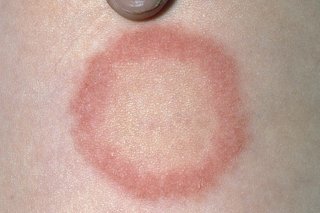
SCIENCE PHOTO LIBRARY https://www.sciencephoto.com/media/262831/view

BSIP SA / Alamy Stock Photo https://www.alamy.com/stock-photo-herpes-49178293.html?pv=1&stamp=2&imageid=6D4451FF-983E-41A0-91D1-7FA4B294D4D7&p=166014&n=465&orientation=0&pn=1&searchtype=0&IsFromSearch=1&srch=foo%3Dbar%26st%3D0%26sortby%3D3%26qt%3Dringworm%26qt_raw%3Dringworm%26qn%3D%26lic%3D3%26edrf%3D0%26mr%3D0%26pr%3D0%26aoa%3D1%26creative%3D%26videos%3D%26nu%3D%26ccc%3D%26bespoke%3D4%26apalib%3D%26ag%3D0%26hc%3D0%26et%3D0x000000000000000000000%26vp%3D0%26loc%3D0%26ot%3D0%26imgt%3D0%26dtfr%3D%26dtto%3D%26size%3D0xFF%26blackwhite%3D%26cutout%3D%26archive%3D1%26name%3D%26groupid%3D%26pseudoid%3D%26userid%3D%26id%3D%26a%3D%26xstx%3D0%26cbstore%3D0%26resultview%3DsortbyRelevant%26lightbox%3D%26gname%3D%26gtype%3D%26apalic%3D%26tbar%3D1%26pc%3D%26simid%3D%26cap%3D1%26customgeoip%3DGB%26vd%3D0%26cid%3D%26pe%3D%26so%3D%26lb%3D%26pl%3D0%26plno%3D%26fi%3D0%26langcode%3Den%26upl%3D0%26cufr%3D%26cuto%3D%26howler%3D%26cvrem%3D0%26cvtype%3D0%26cvloc%3D0%26cl%3D0%26upfr%3D%26upto%3D%26primcat%3D%26seccat%3D%26cvcategory%3D*%26restriction%3D%26random%3D%26ispremium%3D1%26flip%3D0%26contributorqt%3D%26plgalleryno%3D%26plpublic%3D0%26viewaspublic%3D0%26isplcurate%3D0%26imageurl%3D%26saveQry%3D%26editorial%3D%26t%3D0%26apaid%3D%7B18B189B6-6A83-41BD-8442-2448A6B7E281%7D%26custspecid%3D14369B5F-24B7-4344-B743-D5DE569A1F46%26filters%3D0

DR P. MARAZZI/SCIENCE PHOTO LIBRARY https://www.sciencephoto.com/media/262986/view

DR P. MARAZZI/SCIENCE PHOTO LIBRARY https://www.sciencephoto.com/media/262834/view
A pharmacist can help with ringworm
Speak to a pharmacist first if you think you have ringworm.
They can look at the rash and recommend the best antifungal medicine. This might be tablets, cream, gel or spray depending on where the rash is.
You may need to use an antifungal medicine every day for up to 4 weeks. It's important to use it for the right amount of time, even if the rash has gone away.
A pharmacist will tell you if they think you should see a GP.
Small spots and blisters

Phanie / Alamy Stock Photo https://www.alamy.com/stock-photo-chickenpox-on-a-4-month-old-baby-72420194.html?pv=1&stamp=2&imageid=86C877CC-A7B7-4790-A33A-84970C51D1B4&p=218242&n=0&orientation=0&pn=1&searchtype=0&IsFromSearch=1&srch=foo%3dbar%26st%3d0%26pn%3d1%26ps%3d100%26sortby%3d2%26resultview%3dsortbyPopular%26npgs%3d0%26qt%3dE5R0KE%26qt_raw%3dE5R0KE%26lic%3d3%26mr%3d0%26pr%3d0%26ot%3d0%26creative%3d%26ag%3d0%26hc%3d0%26pc%3d%26blackwhite%3d%26cutout%3d%26tbar%3d1%26et%3d0x000000000000000000000%26vp%3d0%26loc%3d0%26imgt%3d0%26dtfr%3d%26dtto%3d%26size%3d0xFF%26archive%3d1%26groupid%3d%26pseudoid%3d%26a%3d%26cdid%3d%26cdsrt%3d%26name%3d%26qn%3d%26apalib%3d%26apalic%3d%26lightbox%3d%26gname%3d%26gtype%3d%26xstx%3d0%26simid%3d%26saveQry%3d%26editorial%3d1%26nu%3d%26t%3d%26edoptin%3d%26customgeoip%3d%26cap%3d1%26cbstore%3d1%26vd%3d0%26lb%3d%26fi%3d2%26edrf%3d0%26ispremium%3d1%26flip%3d0%26pl%3d
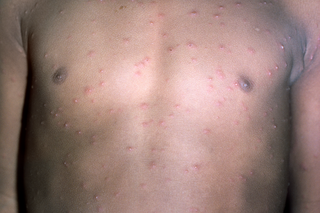
Science Photo Library Image is currently not live on their site as the company who were hiring the image has gone into liquidation. However, the actual owner of the image is looking to subscribe to SPL and has agreed to licence it to us.
Small, itchy spots that turn into blisters and scabs could be chickenpox.
Chickenpox can usually be treated at home.
Chickenpox symptoms and what to do
Check if it's chickenpox
An itchy, spotty rash is the main symptom of chickenpox. It can be anywhere on the body.
Chickenpox happens in 3 stages. But new spots can appear while others are becoming blisters or forming a scab.
Stage 1: small spots appear
The spots can:
- be anywhere on the body, including inside the mouth and around the genitals, which can be painful
- spread or stay in a small area
- be red, pink, darker or the same colour as surrounding skin, depending on your skin tone
- be harder to see on brown and black skin
-
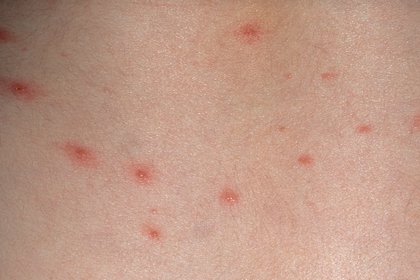 1: White skin with stage 1 of the chickenpox rash (thumbnail).
1
1: White skin with stage 1 of the chickenpox rash (thumbnail).
1
-
 2: Light brown skin with stage 1 of the chickenpox (thumbnail).
2
2: Light brown skin with stage 1 of the chickenpox (thumbnail).
2
-
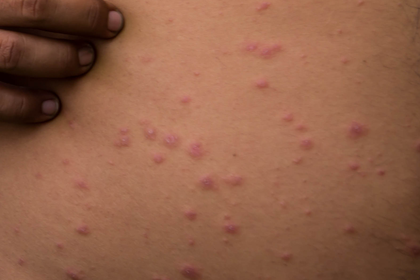 3: Light brown skin with stage 1 of the chickenpox rash (thumbnail).
3
3: Light brown skin with stage 1 of the chickenpox rash (thumbnail).
3

Hercules Robinson / Alamy Stock Photo https://www.alamy.com/stock-photo-vesicles-of-chickenpoxa-virus-infection-due-to-the-variceela-zoster-12876628.html?pv=1&stamp=2&imageid=9D19BDE9-0E58-4C07-87AA-33CB44770B52&p=18517&n=0&orientation=0&pn=1&searchtype=0&IsFromSearch=1&srch=foo%3dbar%26st%3d0%26pn%3d1%26ps%3d100%26sortby%3d2%26resultview%3dsortbyPopular%26npgs%3d0%26qt%3dABF9YH%26qt_raw%3dABF9YH%26lic%3d3%26mr%3d0%26pr%3d0%26ot%3d0%26creative%3d%26ag%3d0%26hc%3d0%26pc%3d%26blackwhite%3d%26cutout%3d%26tbar%3d1%26et%3d0x000000000000000000000%26vp%3d0%26loc%3d0%26imgt%3d0%26dtfr%3d%26dtto%3d%26size%3d0xFF%26archive%3d1%26groupid%3d%26pseudoid%3d%7bA883FDE5-7F3D-4472-81F5-B61111916852%7d%26a%3d%26cdid%3d%26cdsrt%3d%26name%3d%26qn%3d%26apalib%3d%26apalic%3d%26lightbox%3d%26gname%3d%26gtype%3d%26xstx%3d0%26simid%3d%26saveQry%3d%26editorial%3d1%26nu%3d%26t%3d%26edoptin%3d%26customgeoip%3d%26cap%3d1%26cbstore%3d1%26vd%3d0%26lb%3d%26fi%3d2%26edrf%3d0%26ispremium%3d1%26flip%3d0%26pl%3d
Long description, image 1.
White skin with stage 1 chickenpox spots.
There are 10 spots that vary in size, but they're all less than 1cm. Some spots are close to others. Some spots are raised and appear to be forming a round or slightly oval blister. Other spots are flatter.
The spots are red and pink and the skin around the spot is pink.

Science Photo Library https://www.sciencephoto.com/media/252542/view
Long description, image 2.
Light brown skin with stage 1 chickenpox spots. There are more than 40 spots covering a child's chest. The spots are red or pink.
Some spots are close to others. Some appear to be raised in the centre and are beginning to form a blister, while other spots appear flat.

MR . JOE666 https://www.shutterstock.com/image-photo/boy-who-chickenpox-symptoms-red-bumps-1172003791
Long description, image 3.
Light brown skin with stage 1 chickenpox spots.
There are about 50 spots which vary in size, but they're all less than 1cm. Some spots are close to others.
The larger spots are pink. Some of the smaller spots are the same colour as the person's skin tone. Some spots are raised and appear to be forming a round or oval blister in the centre. Other spots are flatter.
Stage 2: the spots become blisters
The spots fill with fluid and become blisters. The blisters are very itchy and may burst.
-
 1: White skin with stage 2 of the chickenpox rash (thumbnail).
1
1: White skin with stage 2 of the chickenpox rash (thumbnail).
1
-
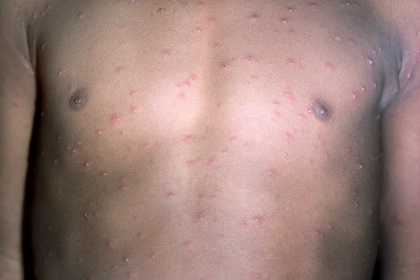 2: Medium brown skin with stage 2 of the chickenpox rash (thumbnail).
2
2: Medium brown skin with stage 2 of the chickenpox rash (thumbnail).
2
-
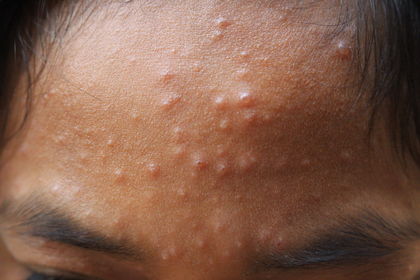 3: Medium brown skin with stage 2 of the chickenpox rash (thumbnail).
3
3: Medium brown skin with stage 2 of the chickenpox rash (thumbnail).
3
-
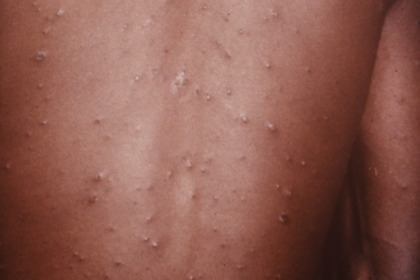 4: Dark brown skin with stage 2 of the chickenpox rash (thumbnail).
4
4: Dark brown skin with stage 2 of the chickenpox rash (thumbnail).
4

Miroslav Beneda / Alamy Stock Photo https://www.alamy.com/stock-photo-detail-baby-with-chicken-pox-rash-53122372.html?pv=1&stamp=2&imageid=55E4EE6E-6F54-4758-A74B-4058E5E59B4E&p=85303&n=0&orientation=0&pn=1&searchtype=0&IsFromSearch=1&srch=foo%3dbar%26st%3d0%26pn%3d1%26ps%3d100%26sortby%3d2%26resultview%3dsortbyPopular%26npgs%3d0%26qt%3dD2BX3G%26qt_raw%3dD2BX3G%26lic%3d3%26mr%3d0%26pr%3d0%26ot%3d0%26creative%3d%26ag%3d0%26hc%3d0%26pc%3d%26blackwhite%3d%26cutout%3d%26tbar%3d1%26et%3d0x000000000000000000000%26vp%3d0%26loc%3d0%26imgt%3d0%26dtfr%3d%26dtto%3d%26size%3d0xFF%26archive%3d1%26groupid%3d%26pseudoid%3d%26a%3d%26cdid%3d%26cdsrt%3d%26name%3d%26qn%3d%26apalib%3d%26apalic%3d%26lightbox%3d%26gname%3d%26gtype%3d%26xstx%3d0%26simid%3d%26saveQry%3d%26editorial%3d1%26nu%3d%26t%3d%26edoptin%3d%26customgeoip%3d%26cap%3d1%26cbstore%3d1%26vd%3d0%26lb%3d%26fi%3d2%26edrf%3d%26ispremium%3d1%26flip%3d0%26pl%3d
Long description, image 1.
White skin with stage 2 chickenpox spots.
There are 13 spots which vary in size, but they're all less than 1cm. Some spots are close to others. Almost all the spots have formed a round or slightly oval blister. 1 spot appears to be flatter.
The blisters are pink and shiny. The skin around some spots appears slightly pink.

Science Photo Library Image is currently not live on their site as the company who were hiring the image has gone into liquidation. However, the actual owner of the image is looking to subscribe to SPL and has agreed to licence it to us.
Long description, image 2.
Medium brown skin with stage 2 chickenpox spots. There are more than 50 chickenpox spots covering a child's chest and upper arms.
The spots vary in size, but they're all less than 1cm. Many of the spots have formed a round or slightly oval shape raised blister. Many of the blisters are white and shiny.
The skin around some of the blisters is pink. A few of the blisters appear to have burst and have formed dark scabs.

Mrs.Rungnapa akthaisong https://www.shutterstock.com/image-photo/girl-had-blister-on-face-due-1319781899
Long description, image 3.
Medium brown skin with stage 2 chickenpox spots and blisters. There are about 40 spots on a person's forehead.
The spots vary in size from around 3mm to 6mm. Some are close to others. Many have formed a round or slightly oval shape raised blister. Some spots appear slightly flatter.
Some blisters are the same colour or slightly paler than the person's skin, while others are slightly pink. Some blisters appear shiny and slightly white or grey.

CDC https://phil.cdc.gov/Details.aspx?pid=4367
Long description, image 4.
Dark brown skin with stage 2 chickenpox spots and blisters. There are about 50 spots on a person's back and arm.
The spots vary in size from around 5mm to 1cm. Some are close to others. Many of the spots have formed a round or slightly oval shape raised blister.
Some of the blisters appear to have burst and some may be forming a scab. Most blisters are the same colour or slightly darker than the person's skin. Some blisters appear shiny and slightly white or grey.
Stage 3: the blisters become scabs
The spots form a scab. Some scabs are flaky while others leak fluid.
-
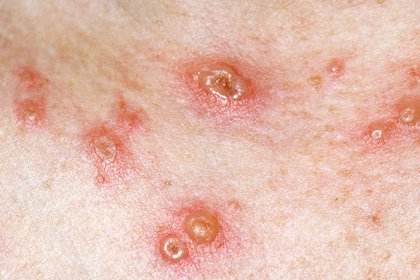 1: White skin with stage 3 of the chickenpox rash (thumbnail).
1
1: White skin with stage 3 of the chickenpox rash (thumbnail).
1
-
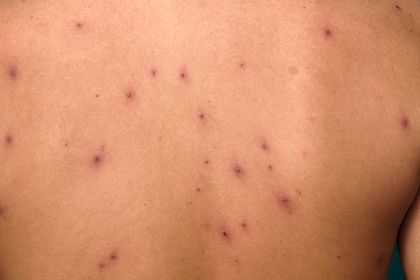 2: Light brown skin with stage 3 of the chickenpox rash (thumbnail).
2
2: Light brown skin with stage 3 of the chickenpox rash (thumbnail).
2
-
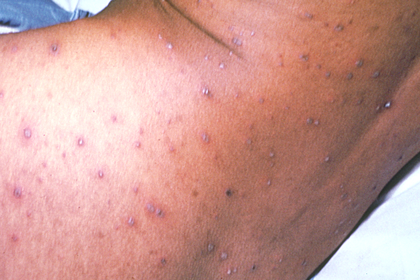 3: Medium brown skin with stage 3 of the chickenpox rash (thumbnail).
3
3: Medium brown skin with stage 3 of the chickenpox rash (thumbnail).
3

Alamy Stock Photo https://www.alamy.com/stock-photo-chicken-pox-lesions-52503353.html?pv=1&stamp=2&imageid=942ABBCD-1E5B-45A0-B303-F69C496349ED&p=17774&n=0&orientation=0&pn=1&searchtype=0&IsFromSearch=1&srch=foo%3dbar%26st%3d0%26pn%3d1%26ps%3d100%26sortby%3d2%26resultview%3dsortbyPopular%26npgs%3d0%26qt%3dD1BMFN%26qt_raw%3dD1BMFN%26lic%3d3%26mr%3d0%26pr%3d0%26ot%3d0%26creative%3d%26ag%3d0%26hc%3d0%26pc%3d%26blackwhite%3d%26cutout%3d%26tbar%3d1%26et%3d0x000000000000000000000%26vp%3d0%26loc%3d0%26imgt%3d0%26dtfr%3d%26dtto%3d%26size%3d0xFF%26archive%3d1%26groupid%3d%26pseudoid%3d%7bA883FDE5-7F3D-4472-81F5-B61111916852%7d%26a%3d%26cdid%3d%26cdsrt%3d%26name%3d%26qn%3d%26apalib%3d%26apalic%3d%26lightbox%3d%26gname%3d%26gtype%3d%26xstx%3d0%26simid%3d%26saveQry%3d%26editorial%3d1%26nu%3d%26t%3d%26edoptin%3d%26customgeoip%3d%26cap%3d1%26cbstore%3d1%26vd%3d0%26lb%3d%26fi%3d2%26edrf%3d0%26ispremium%3d1%26flip%3d0%26pl%3d
Long description, image 1.
White skin with stage 3 chickenpox spots, blisters and scabs.
There are about 14 spots which vary in size from around 1mm to 1cm. Some are close together.
Some of the spots look like very small pink blisters. Some are larger, raised and have a scab over them. Some scabs look soft and seem to have fluid under them.
2 of the scabs appear to have collapsed in the centre. The scabs are yellow and pink and the skin around the scabs is pink.

Science Photo Library https://www.sciencephoto.com/media/877204/view
Long description, image 2.
Light brown skin with stage 3 chickenpox spots and scabs. There are about 25 spots on a person's upper back.
Some spots are 1cm to 3cm apart, some are further apart. Most spots are flat, less than 5mm, and have dark red scabs. The skin around many of the scabs appears pink.

CDC/ J.D. Millar, MD, MPH, DTPH https://phil.cdc.gov/Details.aspx?pid=2885
Long description, image 3.
Medium brown skin with stage 3 chickenpox spots. The spots cover the lower part of a person's back and the side of their hip.
There are about 50 spots in total, varying in size from about 1mm to 1cm. Some are 1cm to 3cm apart, but others are further apart.
Most of the spots have scabs over them. The scabs are pink, purple or grey. There are also a few spots without scabs, which look like small blisters. These are slightly darker in colour than the person's skin.
Other symptoms
Before or after the rash appears, you might also get:
- a high temperature
- aches and pains, and generally feeling unwell
- loss of appetite
Chickenpox is very itchy and can make children feel miserable, even if they do not have many spots.
The chickenpox spots look the same on children and adults. But adults usually have a high temperature for longer and more spots than children.
It's possible to get chickenpox more than once, but it's unusual.
How to treat chickenpox at home
Important: Stay off school or work
You'll need to stay away from school, nursery or work until all the spots have formed a scab. This is usually 5 days after the spots appeared.
Do
-
drink plenty of fluid (try ice lollies if your child is not drinking) to avoid dehydration
-
take paracetamol to help with pain and discomfort
-
cut your child's fingernails and put socks on their hands at night to stop them scratching
-
use cooling creams or gels from a pharmacy
-
speak to a pharmacist about using antihistamine medicine to help itching
-
bathe in cool water and pat the skin dry (do not rub)
-
dress in loose clothes
Don’t
-
do not use ibuprofen unless advised to do so by a doctor, as it may cause serious skin infections
-
do not give aspirin to children under 16
-
do not go near newborn babies, or anyone who is pregnant or has a weakened immune system, as chickenpox can be dangerous for them
-
do not scratch the spots, as scratching can cause scarring
Itchy sores or blisters
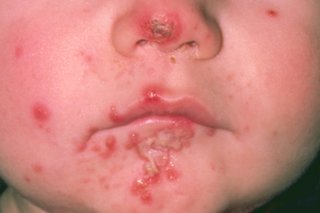
DR P. MARAZZI/SCIENCE PHOTO LIBRARY https://www.sciencephoto.com/media/258826/view
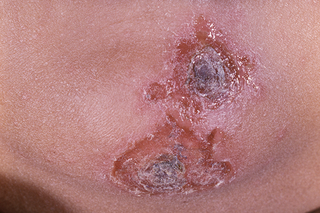
DR M.A. ANSARY / SCIENCE PHOTO LIBRARY https://www.sciencephoto.com/media/258867/view
Sores or blisters that burst and leave crusty, golden-brown patches could be impetigo. The sores or blisters can be itchy, get bigger or spread to other parts of the body.
Speak to a GP if you think your child may have impetigo.
Impetigo symptoms and what to do
Impetigo is a skin infection that's very contagious but not usually serious. It often gets better in 7 to 10 days if you get treatment. Anyone can get it, but it's very common in young children.
If you're not sure it's impetigo
Impetigo can look similar to other skin conditions.
| Skin symptoms | Possible cause |
|---|---|
| Blisters on lips or around the mouth | Cold sores |
| Itchy, dry, cracked, sore | Eczema |
| Itchy blisters | Shingles, chickenpox |
Small and very itchy spots

Alamy Stock Photo https://www.alamy.com/scabies-image1683610.html?pv=1&stamp=2&imageid=BF2924B0-F44D-4E74-9AE3-019941C68B3D&p=17774&n=0&orientation=0&pn=1&searchtype=0&IsFromSearch=1&srch=foo%3dbar%26st%3d0%26pn%3d1%26ps%3d100%26sortby%3d2%26resultview%3dsortbyPopular%26npgs%3d0%26qt%3dATB09B%26qt_raw%3dATB09B%26lic%3d3%26mr%3d0%26pr%3d0%26ot%3d0%26creative%3d%26ag%3d0%26hc%3d0%26pc%3d%26blackwhite%3d%26cutout%3d%26tbar%3d1%26et%3d0x000000000000000000000%26vp%3d0%26loc%3d0%26imgt%3d0%26dtfr%3d%26dtto%3d%26size%3d0xFF%26archive%3d1%26groupid%3d%26pseudoid%3d195878%26a%3d%26cdid%3d%26cdsrt%3d%26name%3d%26qn%3d%26apalib%3d%26apalic%3d%26lightbox%3d%26gname%3d%26gtype%3d%26xstx%3d0%26simid%3d%26saveQry%3d%26editorial%3d1%26nu%3d%26t%3d%26edoptin%3d%26customgeoip%3d%26cap%3d1%26cbstore%3d1%26vd%3d0%26lb%3d%26fi%3d2%26edrf%3d0%26ispremium%3d1%26flip%3d0%26pl%3d
Very itchy raised spots could be caused by tiny mites that burrow into the skin (scabies). There may be raised lines with a dot at one end, often first appearing between the fingers.
Scabies can usually be treated at home.
Scabies symptoms and what to do
Check if it's scabies
The symptoms of scabies are:
- intense itching, especially at night
- a raised rash or spots
The spots may look red. They are more difficult to see on brown or black skin, but you should be able to feel them.
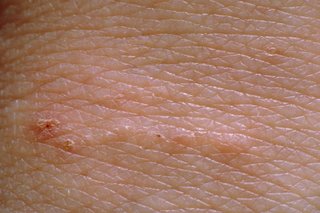
JOHN RADCLIFFE HOSPITAL/SCIENCE PHOTO LIBRARY https://www.sciencephoto.com/media/262408/view

DR P. MARAZZI/SCIENCE PHOTO LIBRARY https://www.sciencephoto.com/media/262479/view

DR P. MARAZZI/SCIENCE PHOTO LIBRARY https://www.sciencephoto.com/media/262452/view
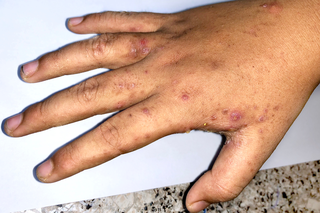
Zay Nyi Nyi https://www.shutterstock.com/image-photo/scabies-infestation-right-hand-southeast-asian-1410825806
The scabies rash usually spreads across the whole body, apart from the head and neck. It often affects skin between the fingers, around the wrists, under the arms, and around the waist, groin and bottom.
However, older people and young children may develop a rash on their head, neck, palms and soles of their feet.
People with a weakened immune system can sometimes get a rare and very contagious type of scabies, called crusted scabies. The main symptom is a crusted, flaky rash that often affects the elbows, knees, hands and feet.
A pharmacist can help with scabies
Scabies is not usually a serious condition, but it does need to be treated.
A pharmacist will recommend a cream or lotion that you apply over your whole body. It's important to read the instructions carefully.
Let the pharmacist know if you're breastfeeding or pregnant.
You'll need to repeat the treatment 1 week later.
Scabies is very infectious, but it can take up to 8 weeks for the rash to appear.
Everyone in your home needs to be treated at the same time, even if they do not have symptoms. But do not use pharmacy treatments on children under 2 years old, they will need to see a GP.
Anyone you’ve had sexual contact with in the past 8 weeks should also be treated.
Rash without fever or itching
Tiny spots on a baby's face

Jack Sullivan / Alamy Stock Photo https://www.alamy.com/milk-spots-or-milia-on-babys-nose-image6899614.html?pv=1&stamp=2&imageid=46C270BC-A967-4C51-8379-7C3EA3052DD3&p=3609&n=0&orientation=0&pn=1&searchtype=0&IsFromSearch=1&srch=foo%3dbar%26st%3d0%26pn%3d1%26ps%3d100%26sortby%3d2%26resultview%3dsortbyPopular%26npgs%3d0%26qt%3dA8E2HF%26qt_raw%3dA8E2HF%26lic%3d3%26mr%3d0%26pr%3d0%26ot%3d0%26creative%3d%26ag%3d0%26hc%3d0%26pc%3d%26blackwhite%3d%26cutout%3d%26tbar%3d1%26et%3d0x000000000000000000000%26vp%3d0%26loc%3d0%26imgt%3d0%26dtfr%3d%26dtto%3d%26size%3d0xFF%26archive%3d1%26groupid%3d%26pseudoid%3d%26a%3d%26cdid%3d%26cdsrt%3d%26name%3d%26qn%3d%26apalib%3d%26apalic%3d%26lightbox%3d%26gname%3d%26gtype%3d%26xstx%3d0%26simid%3d%26saveQry%3d%26editorial%3d1%26nu%3d%26t%3d%26edoptin%3d%26customgeoip%3d%26cap%3d1%26cbstore%3d1%26vd%3d0%26lb%3d%26fi%3d2%26edrf%3d0%26ispremium%3d1%26flip%3d0%26pl%3d
Very small spots, called milia, often appear on a baby's face when they're a few days old. Milia may appear white or yellow, depending on your baby's skin colour.
They usually go away within a few weeks and do not need treatment.
Red, yellow and white spots in babies
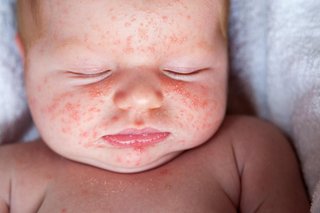
David Gee 4 / Alamy Stock Photo https://www.alamy.com/stock-photo-two-week-old-with-probably-neonatal-baby-acne-or-erythema-toxicum-72185718.html?pv=1&stamp=2&imageid=B319E66D-754D-45DC-8FE4-CB90C93F2D6F&p=79815&n=0&orientation=0&pn=1&searchtype=0&IsFromSearch=1&srch=foo%3dbar%26st%3d0%26pn%3d1%26ps%3d100%26sortby%3d2%26resultview%3dsortbyPopular%26npgs%3d0%26qt%3dE5C9HA%26qt_raw%3dE5C9HA%26lic%3d3%26mr%3d0%26pr%3d0%26ot%3d0%26creative%3d%26ag%3d0%26hc%3d0%26pc%3d%26blackwhite%3d%26cutout%3d%26tbar%3d1%26et%3d0x000000000000000000000%26vp%3d0%26loc%3d0%26imgt%3d0%26dtfr%3d%26dtto%3d%26size%3d0xFF%26archive%3d1%26groupid%3d%26pseudoid%3d%26a%3d%26cdid%3d%26cdsrt%3d%26name%3d%26qn%3d%26apalib%3d%26apalic%3d%26lightbox%3d%26gname%3d%26gtype%3d%26xstx%3d0%26simid%3d%26saveQry%3d%26editorial%3d1%26nu%3d%26t%3d%26edoptin%3d%26customgeoip%3d%26cap%3d1%26cbstore%3d1%26vd%3d0%26lb%3d%26fi%3d2%26edrf%3d0%26ispremium%3d1%26flip%3d0%26pl%3d
Raised red, yellow and white spots (erythema toxicum) can appear on babies when they're born. They usually appear on the face, body, upper arms and thighs.
The rash can disappear and reappear. It should get better in a few weeks without treatment.
Skin-coloured or pink spots
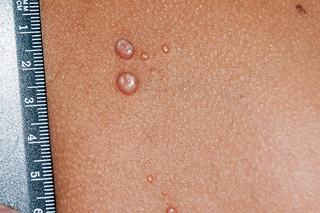
DR HAROUT TANIELIAN / SCIENCE PHOTO LIBRARY
https://www.sciencephoto.com/media/729489/view
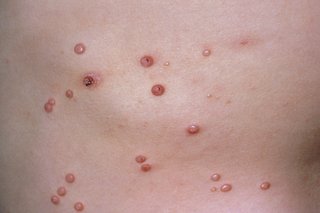
DR P. MARAZZI/SCIENCE PHOTO LIBRARY https://www.sciencephoto.com/media/259439/view
Small, firm, raised spots could be molluscum contagiosum. The spots can be the same colour as surrounding skin, darker than surrounding skin, or pink.
You can usually treat molluscum contagiosum at home.
Molluscum contagiosum symptoms and what to do
Check if it's molluscum contagiosum
Molluscum contagiosum is more common in children, but anyone can get it.
Usually, the only symptom of molluscum contagiosum is spots.

DR P. MARAZZI/SCIENCE PHOTO LIBRARY https://www.sciencephoto.com/media/259439/view
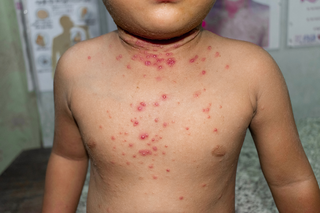
Zay Nyi Nyi:
https://www.shutterstock.com/image-photo/multiple-viral-skin-lesions-called-molluscum-1737390707
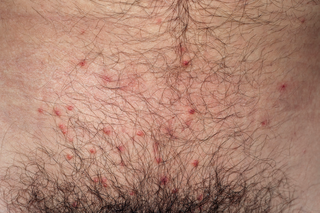
DR HAROUT TANIELIAN / SCIENCE PHOTO LIBRARY
https://www.sciencephoto.com/media/88279/view
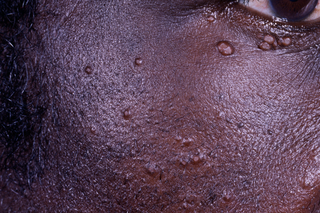
DR M.A. ANSARY / SCIENCE PHOTO LIBRARY
https://www.sciencephoto.com/media/259628/view
How to look after yourself or your child
The spots caused by molluscum contagiosum are usually harmless and should clear up within 18 months without needing treatment.
Molluscum contagiosum is contagious. It is usually passed on by direct skin to skin contact.
The chance of passing it on to other people during normal activities is small so you or your child should be able to carry on with your normal activities. If you are not sure, check with a GP.
There are some things you can do to help reduce the risk of the infection spreading and help ease any symptoms.
Do
-
try things to help with dryness and itchy skin, such as holding a damp towel against the skin, having cool baths or using an unperfumed moisturiser regularly
-
keep the affected area covered, including using waterproof bandages if you go swimming
-
use a condom while having sex if you are infected
Don’t
-
do not squeeze or scratch the spots, as it could cause an infection or scarring
-
do not share baths or things such as towels, bedding or clothes
Red patches on a baby's bottom
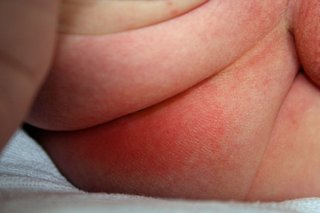
Family / Alamy Stock Photo https://www.alamy.com/stock-photo-nappy-rash-on-babys-bottom-41339900.html?pv=1&stamp=2&imageid=50E1A9DD-2929-435E-92CF-B6DFDFB2C725&p=143434&n=0&orientation=0&pn=1&searchtype=0&IsFromSearch=1&srch=foo%3dbar%26st%3d0%26pn%3d1%26ps%3d100%26sortby%3d2%26resultview%3dsortbyPopular%26npgs%3d0%26qt%3dCB75D0%26qt_raw%3dCB75D0%26lic%3d3%26mr%3d0%26pr%3d0%26ot%3d0%26creative%3d%26ag%3d0%26hc%3d0%26pc%3d%26blackwhite%3d%26cutout%3d%26tbar%3d1%26et%3d0x000000000000000000000%26vp%3d0%26loc%3d0%26imgt%3d0%26dtfr%3d%26dtto%3d%26size%3d0xFF%26archive%3d1%26groupid%3d%26pseudoid%3d%26a%3d%26cdid%3d%26cdsrt%3d%26name%3d%26qn%3d%26apalib%3d%26apalic%3d%26lightbox%3d%26gname%3d%26gtype%3d%26xstx%3d0%26simid%3d%26saveQry%3d%26editorial%3d1%26nu%3d%26t%3d%26edoptin%3d%26customgeoip%3d%26cap%3d1%26cbstore%3d1%26vd%3d0%26lb%3d%26fi%3d2%26edrf%3d0%26ispremium%3d1%26flip%3d0%26pl%3d
If your baby has a red and sore bottom, it could be nappy rash.
Nappy rash can usually be treated at home.
Nappy rash symptoms and what to do
Check if your baby has nappy rash
Symptoms of nappy rash can include:
- red or raw patches on your baby’s bottom or the whole nappy area
- skin that looks sore and feels hot to touch
- scaly and dry skin
- an itchy or painful bottom
- your baby seeming uncomfortable or distressed
- spots, pimples, or blisters on bottom (spots can appear red or brown, but may be less noticeable on brown and black skin)
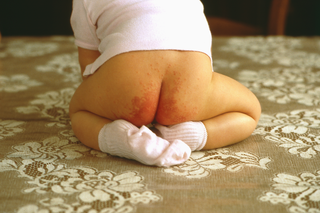
HOUIN / BSIP / SCIENCE PHOTO LIBRARY: https://www.sciencephoto.com/media/615341/view
Things you can do to help with nappy rash
Nappy rash can be treated and prevented by following some simple advice.
Do
-
change wet or dirty nappies as soon as possible
-
keep the skin clean and dry – pat or rub the skin gently to dry it
-
leave nappies off when possible
-
use extra absorbent nappies
-
make sure your baby's nappies fit properly
-
clean your baby's skin with water or fragrance-free and alcohol-free baby wipes
-
bath your baby daily (but not more than twice a day, as washing too much can make the skin dry out)
Don’t
-
do not use soaps, baby lotion or bubble bath as they can irritate the skin
-
do not use talcum powder or antiseptics on nappy rash
-
do not put nappies on too tightly as it can irritate the skin
A pharmacist can help with nappy rash
If the rash is causing your baby discomfort, a pharmacist can recommend a nappy rash cream or medicine to treat it at home.
They may suggest using a thin layer of a barrier cream to protect the skin or giving your baby child's paracetamol for pain relief (only suitable for babies over 2 months old).
Pimples on the cheeks, nose and forehead
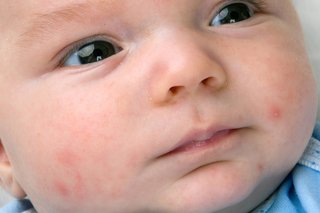
Was previously from: sframephoto / Thinkstock T_1017_baby-acne_136651134.jpg If required, can be purchased from: Steven Frame / Alamy Stock Photo https://www.alamy.com/stock-photo-close-up-of-newborn-babys-face-with-red-rash-acne-and-pimples-common-41797234.html?pv=1&stamp=2&imageid=0A549EF2-FF5D-419F-AA3B-BE8EC09E49CB&p=79893&n=0&orientation=0&pn=1&searchtype=0&IsFromSearch=1&srch=foo%3dbar%26st%3d0%26pn%3d1%26ps%3d100%26sortby%3d2%26resultview%3dsortbyPopular%26npgs%3d0%26qt%3dBABY%2520ACNE%26qt_raw%3dBABY%2520ACNE%26lic%3d3%26mr%3d0%26pr%3d0%26ot%3d0%26creative%3d%26ag%3d0%26hc%3d0%26pc%3d%26blackwhite%3d%26cutout%3d%26tbar%3d1%26et%3d0x000000000000000000000%26vp%3d0%26loc%3d0%26imgt%3d0%26dtfr%3d%26dtto%3d%26size%3d0xFF%26archive%3d1%26groupid%3d%26pseudoid%3d788068%26a%3d%26cdid%3d%26cdsrt%3d%26name%3d%26qn%3d%26apalib%3d%26apalic%3d%26lightbox%3d%26gname%3d%26gtype%3d%26xstx%3d0%26simid%3d%26saveQry%3d%26editorial%3d1%26nu%3d%26t%3d%26edoptin%3d%26customgeoip%3d%26cap%3d1%26cbstore%3d1%26vd%3d0%26lb%3d%26fi%3d2%26edrf%3d0%26ispremium%3d1%26flip%3d0%26pl%3d
Spots that appear on a baby's cheeks, nose or forehead within a month after birth could be baby acne.
You do not need to treat baby acne. It usually gets better after a few weeks or months.
Yellow, scaly patches on the scalp
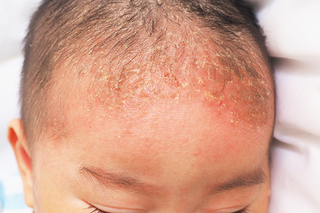
Eaaw https://www.shutterstock.com/image-photo/seborrheic-dermatitis-on-head-asian-baby-561450823
Yellow or white, greasy, scaly patches on your baby's scalp could be cradle cap.
Cradle cap can usually be treated at home.
Cradle cap symptoms and what to do
Check if your baby has cradle cap
The main symptom of cradle cap is patches of greasy, scaly skin.
It's usually found on the scalp and face, but sometimes affects the nappy area. It can look like:
- patches of white or yellow greasy scales on the scalp and face that form a crust which might flake off
- small, dry flakes of skin on the nappy area
The scales look similar on all skin tones. But the skin under the scales may look pink or red if your baby has white skin, or lighter or darker than the surrounding skin if your baby has brown or black skin.
It is not itchy or painful and does not bother your baby.
The cause of cradle cap is not clear, but it cannot be caught from other babies.
-
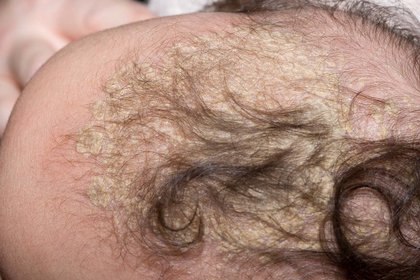 1: Cradle cap on the scalp of a baby with white skin (thumbnail).
1
1: Cradle cap on the scalp of a baby with white skin (thumbnail).
1
-
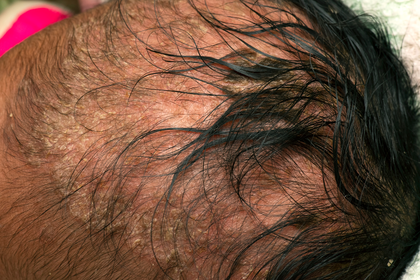 2: Cradle cap on the scalp of a baby with medium brown skin (thumbnail).
2
2: Cradle cap on the scalp of a baby with medium brown skin (thumbnail).
2
-
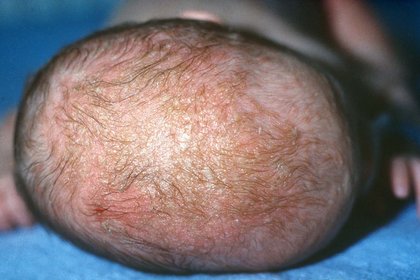 3: Cradle cap on the scalp of a baby with white skin (thumbnail).
3
3: Cradle cap on the scalp of a baby with white skin (thumbnail).
3
-
 4: Cradle cap on the eyebrows of a baby with white skin (thumbnail).
4
4: Cradle cap on the eyebrows of a baby with white skin (thumbnail).
4

DR P. MARAZZI/SCIENCE PHOTO LIBRARY https://www.sciencephoto.com/media/567974/view
Long description, image 1.
Cradle cap on the scalp of a baby with white skin and dark brown hair.
A pale yellow crust covers the top of the head. The crust ends at the hairline, just above the forehead. The crust has many scales of skin, many of which join together. There are no scales on the forehead.

Science Photo Library
https://www.sciencephoto.com/media/1191488/view
Long description, image 2.
Cradle cap on the scalp of a baby with medium brown skin and black hair.
A large oval area on the top of the head looks pink with many pale brown patches. There are also many pale yellow, flaky scales. At the edge of the patch of cradle cap, closest to the forehead, the scales are close together and form a crust. There's also a crust at the top of the head, with hair covering it.

Biophoto Associates/SCIENCE PHOTO LIBRARY https://www.sciencephoto.com/media/699021/view
Long description, image 3.
Cradle cap on the scalp of a baby with white skin and pale brown hair.
An oval-shape patch of cradle cap spreads from the forehead to the top of the head. The skin in this area looks pink with many greasy, pale yellow scales. Most scales are close together, forming a crust, but some scales are further apart.
There's a small, round, darker pink patch of cradle cap on the head, in the lower left part of the image.

Enid English / Alamy Stock Photo https://www.alamy.com/stock-photo-a-three-week-old-bay-with-cradle-cap-on-the-eye-brows-uk-72546963.html?pv=1&stamp=2&imageid=746A9B75-BE6E-4761-B017-402502B1F105&p=84355&n=0&orientation=0&pn=1&searchtype=0&IsFromSearch=1&srch=foo%3dbar%26st%3d0%26pn%3d1%26ps%3d100%26sortby%3d2%26resultview%3dsortbyPopular%26npgs%3d0%26qt%3dE60PAY%26qt_raw%3dE60PAY%26lic%3d3%26mr%3d0%26pr%3d0%26ot%3d0%26creative%3d%26ag%3d0%26hc%3d0%26pc%3d%26blackwhite%3d%26cutout%3d%26tbar%3d1%26et%3d0x000000000000000000000%26vp%3d0%26loc%3d0%26imgt%3d0%26dtfr%3d%26dtto%3d%26size%3d0xFF%26archive%3d1%26groupid%3d%26pseudoid%3d32846%26a%3d%26cdid%3d%26cdsrt%3d%26name%3d%26qn%3d%26apalib%3d%26apalic%3d%26lightbox%3d%26gname%3d%26gtype%3d%26xstx%3d0%26simid%3d%26saveQry%3d%26editorial%3d1%26nu%3d%26t%3d%26edoptin%3d%26customgeoip%3d%26cap%3d1%26cbstore%3d1%26vd%3d0%26lb%3d%26fi%3d2%26edrf%3d1%26ispremium%3d1%26flip%3d0%26pl%3d
Long description, image 4.
Cradle cap on the face of a baby with white skin.
A raised crust of yellow scales covers the inner corners of each eyebrow. The crust is thickest towards the middle of their face. The eyebrow on the right side of the photo has a 2nd, smaller patch of crusty scales at the end.
The forehead and cheeks are covered in many tiny pink spots.
Things you can do to help with cradle cap
Do
-
lightly massage an emollient (moisturiser) on to your baby's scalp to help loosen the scales
-
gently brush your baby's scalp with a soft brush and then wash it with baby shampoo
Don’t
-
do not use olive oil, it may not be suitable for use on skin
-
do not use peanut oil (because of the allergy risk)
-
do not use soap or adult shampoos
-
do not pick crusts because this can increase the chance of infection
Your baby's hair may come away with the scales. Do not worry if this happens as it will soon grow back.
A pharmacist can help with cradle cap
You can ask a pharmacist about:
- an emollient you can use on your baby's scalp
- unperfumed baby shampoos
- barrier creams to use on your baby's nappy area, if it's also affected
Page last reviewed: 11 June 2021
Next review due: 11 June 2024